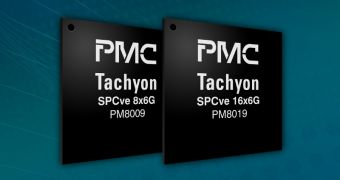To help with data security on the cloud and data center market, PMC has created a pair of 6 Gbps SAS/SATA protocol controllers that aim to provide data security, not just performance.
Consumers might not know, but how fast they get access to online data and how safe their devices are from cyber threats depends, in a significant measure, on the performance and security of the data centers that hold the data.
To meet both those needs, PMC invented the eight-port PM8009 8x6G and the 16-port PM8019 16x6G 6 Gbps SAS/SATA controllers.
They both have the StorClad technology, 256-bit AES-XTS data encryption and an overall advanced set of security features, like FIPS/NIST-certifiable ECB-AES encryption mode, Internal Data Encryption Key (DEK) cache, etc.
“Legacy solutions for securing data-at-rest with encryption, including expensive appliances, performance-limited software and premium-priced self-encrypting HDDs, are complex and expensive,” said Derek Dicker, vice president of marketing for PMC’s Enterprise Storage Division.
“Integrating StorClad technology into PMC’s SAS/SATA controller family builds on our field-proven Fibre Channel encryption solutions, and gives OEMs and cloud storage providers a path to deliver high-performance data security in next-generation storage systems, while maintaining their existing SAS software drivers and infrastructure.”
The SPCve architecture used as the basis of these controllers is compatible with previous0-generation Tachyon SAS controllers. Select partners should already be able to get the newcomers.
“As 6Gb/s SAS/SATA controllers are broadly deployed in both server and external storage architectures, adding encryption to the SAS/SATA I/O path is a practical and cost-effective approach to securing data,” said Benjamin S. Woo, program vice president, worldwide storage systems research, IDC.
“Regardless of whether it’s regulation or shared storage models driving the need for data security, it’s becoming essential to protect sensitive content from security breaches.”

 14 DAY TRIAL //
14 DAY TRIAL //